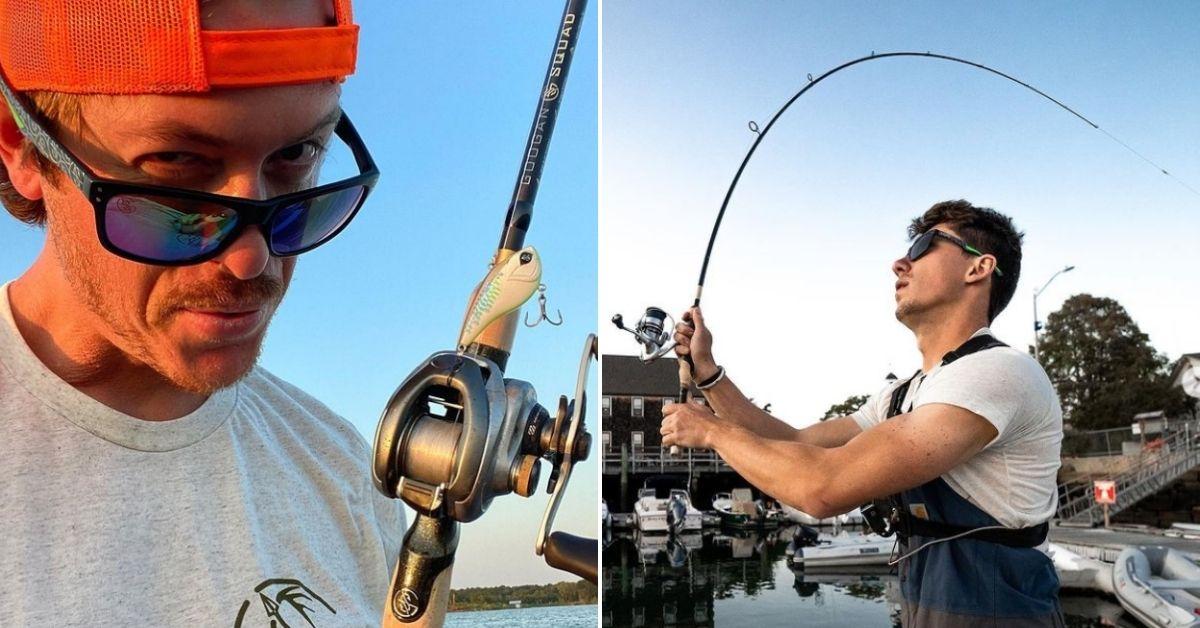When To Use A Spinning Vs Baitcasting Rod, Explained
Choosing a spinning or baitcasting rod can be a challenge for new anglers. Generally, your skill level and the species of fish you enjoy catching will determine which type of fishing rod you should select.
The two basic types of rods are casting and spinning rods. Casting rods are designed for baitcast and spincast reels whereas spinning rods are matched with spinning reels. Let’s take a look at the differences between the two types and how to determine which one you should choose for your style of fishing.
Casting Rods
Lake Fork Guy fishing a crankbait on the Googan Squad Casting Rod
A casting rod is equipped with a reel seat that positions a spincast or baitcast reel above the rod and all the rod guides face upward. When fighting a fish on a casting rod the rod bends over with the guides facing up so the force of the fish pushes the line down on the eyelets and the rod blank. This prevents a big fish from pulling the eyelets off of the rod. Long casting rods with straight handles are designed for power fishing bass tactics and trolling or surfcasting for large fish such as blue or flathead catfish, salmon, striped bass and much powerful saltwater fish. These rods usually have larger rod guides to handle the heavier line of baitcast reels. Shorter casting rods with pistol grip handles and smaller rod guides can be matched with spincast reels filled with lighter line. This combination is ideal for beginners because it is easier to cast than the baitcast combo. The spincast outfit works best for catching panfish, trout and other smaller fish species with artificial lures or live bait.
Line flies straight off a baitcast reel so casting rods have smaller guides than spinning rods near the butt of the rod and the guides gradually taper down in size. The smaller guides mean less resistance on the line as it glides through the eyes allowing baitcast combos to provide better casting distance and accuracy than spinning combos in most instances.
The accuracy of a casting rod is especially important to bass anglers who want to make precise pitches or flips to specific targets where big bass are lurking. Casting rods also allow bass anglers to make accurate short roll casts beneath overhanging branches of trees along the bank or under dock platforms.
The power of a long casting rod allows anglers to easily wind in bigger lures such as magnum swimbaits, deep-diving crankbaits, and Alabama rigs, and vertical jig with heavy slab spoons. Heavy-duty casting rods are also best for winching heavyweight bass out of thick vegetation or brush.
Spinning Rods
Jon B with the Googan Squad Spinning Rod
Unlike the casting rod, a spinning rod holds the spinning reel under the rod with the rod guides facing downward. So when you are fighting a fish, the force of the line pressed against the eyelet is pushing away from the rod blank and could lead to a big fish pulling an eyelet off of the rod. Spinning rods vary in lengths and actions for catching a variety of fish. You can use shorter ultralight or light action spinning rods with thin line for panfish or trout. Medium and medium-heavy action 6- to 7-foot rods are ideal for finesse bass fishing tactics. Long heavy action rods with elongated grip handles for two-handed casting are best for surfcasting for saltwater fish or steelhead and salmon fishing.
The guides on a spinning rod are large and heavily tapered towards the end of the rod because the line comes off a spinning reel in large loops or coils. The tapered guides reduce the size of the coils to send the line out straight. The straightening out process does create friction on the line, which slightly slows the casting speed and reduces distance.
The light backbone power of a spinning rod enables it to load up properly during the casting process so an angler can cast lightweight lures longer distances in either calm or windy conditions, which would be impossible on a casting rod with heavier power. A spinning rod's medium or moderate action also delivers greater casting distance with bobber-and-jig setups for crappie or sunfish and float-and-fly tactics for bass.
Light or ultralight spinning rods are the top picks for crappie anglers adept at shooting jigs under docks and short ultralight spinning rods are ideal for ice fishing.
Some bass anglers prefer skipping tube baits and finesse jigs under dock catwalks or limbs of overhanging trees to avoid the hassle of backlashes that can occur when skipping lures with baitcast gear. Spinning rods are also popular for trolling or fishing with live bait for catfish, panfish and walleye.
Updated February 23rd, 2022 at 4:54 AM CT


